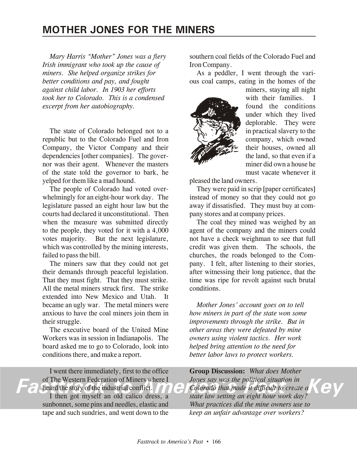| Fasttrack
to America's Past Teacher Key |
|
| Fasttrack
to America's Past Teacher Key |
|
 Page 166 |
Page 166 -
Mother Jones for the Miners The reading selection Mary Harris "Mother" Jones was one of the most interesting and inspiring characters of her era. An Irish immigrant by way of Canada, she lost her husband and children in a yellow fever epidemic in Memphis in 1857. Jones took up the cause of workers in the 1870s. Miners and child labor became the focus of her work after 1880. She continued the fight for fair treatment in the workplace right up to her death in 1930. She called the miners "my boys." They called her Mother Jones. When she died, an estimated 50,000 people attended her funeral. She embraced the ideas of socialism for a time, and was considered quite radical by some. Her fight, however, was not motivated so much by abstract political ideology as by a vigorous moral outrage at the injustices she saw around her. The selection in the workbook is from her autobiography. It gives a good sense of the energy and creativity she brought to every labor dispute she was involved in. The picture Mother Jones was the affectionate name miners gave Mary Harris Jones. She remained active in the fight for miners rights, and against child labor, well into old age. Group discussion question Mother Jones says that
the political
system was not functioning as a democracy in Colorado, but instead, was
in the hands of mining companies. She says that the governor, the
courts, and the legislature were all influenced or controlled by the
mine
owners. She says mine owners used a number of tactics to keep an unfair advantage over the workers. For example, the mining companies typically owned the miners' houses. The result was that workers feared being thrown out if they complained about work conditions. Often the men were paid in scrip (paper certificates with a dollar value printed on them) rather than real money. That made it hard for a worker to leave the mine, since it was hard to accumulate savings in real money.
|
|
Copyright Notice
Copyright 2018 by David Burns. All rights reserved. Illustrations and reading selections appearing in this work are taken from sources in the public domain and from private collections used by permission. Sources include: the Dover Pictorial Archive, the Library of Congress, The National Archives, The Hart Publishing Co., Corel Corporation and its licensors, Nova Development Corporation and its licensors, and others. Maps were created or adapted by the author using reference maps from the United States Geological Survey and Cartesia Software. Please see the home page for this title for more information. |